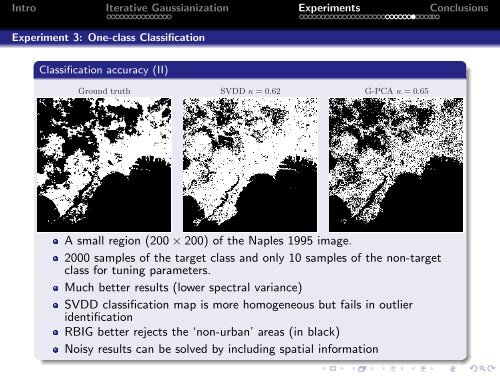Multivariate Gaussianization for Data Processing
Multivariate Gaussianization for Data Processing
Multivariate Gaussianization for Data Processing
You also want an ePaper? Increase the reach of your titles
YUMPU automatically turns print PDFs into web optimized ePapers that Google loves.
Intro Iterative <strong>Gaussianization</strong> Experiments ConclusionsExperiment 3: One-class ClassificationClassification accuracy (II)Ground truth SVDD κ = 0.62 G-PCA κ = 0.65A small region (200 × 200) of the Naples 1995 image.Figure 6. Classification per<strong>for</strong>mance over a small region of the Naples image (1995). White points represent urban areaswhile black 2000 points represent samples non-urban of theareas.target class and only 10 samples of the non-targetclass <strong>for</strong> tuning parameters.Much better results (lower 6. spectral CONCLUSIONS variance)We proposed SVDD a fast alternative classification to iterative map <strong>Gaussianization</strong> is more homogeneous methods that but makes fails it suitable in outlier in high-dimensionalproblems such identificationas those in remote sensing applications. The proposed G-PCA consists of iteratively applyingmarginal <strong>Gaussianization</strong> and PCA to any original dataset. The result is a multivariate Gaussian. TheoreticalRBIG better rejects the ‘non-urban’ areas (in black)convergence of the proposed method was proved.The methodNoisyexhibits resultsfast canandbe stablesolvedconvergenceby includingrates throughspatialain<strong>for</strong>mationsuitable early-stopping criterion. Thecomputational cost is dramatically reduced compared to ICA-based <strong>Gaussianization</strong> methods. The proposed












